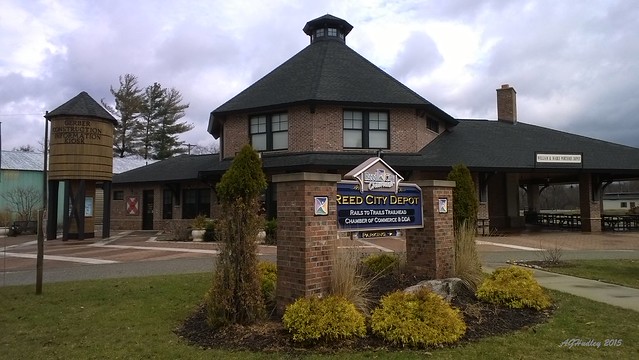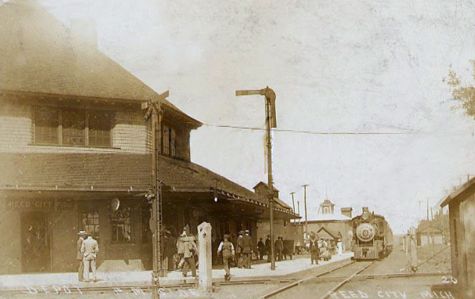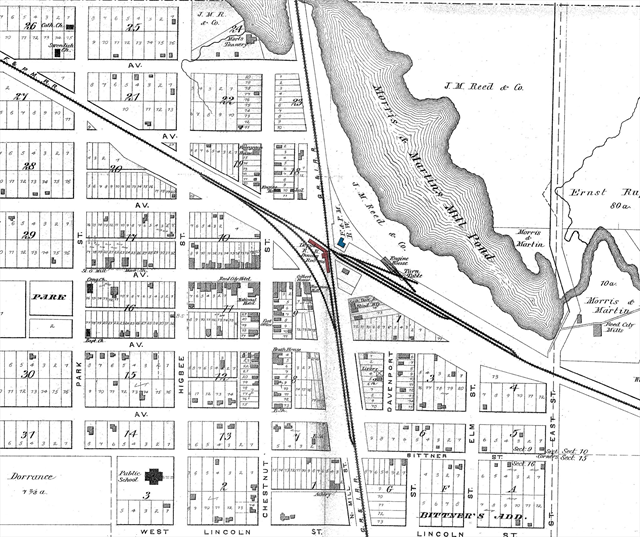
Photo by A.G. Hudley, 2015.
Reed City Crossing, a replica of the former depot that was just south-east at the diamond.
Reed City
Reed City Village was founded by W.M. Slosson, F.H. Todd, W.A. Higbee and J.M. Reed. The population was, at first, less than twenty people. There was great excitement about the location for a village centered around the imminent arrival of two railroads, one from the east and another from the south. The place was locally know as Tunshla, meaning the unknown, and later Todd's Slashings, for the timbered land belonging to Todd. It was platted in 1870 as Reed City. A post office was opened on December 8th, 1871, with Simpson Traut, postmaster. The village was officially incorporated by a special act of the legislature in 1872. The act was found to be unlawful by the courts and village was re-incorporated in 1875. The County Seat was moved here from Hersey in 1927. Reed City was incorporated as a city in 1932.
By 1884, the town was booming with a population already over 2000. There were two flour mills, at least three planing mills, a furniture factory, a grain elevator, a woolen mill, a brick manufacture, a Marble and Granite works. There were many loads of freight shipped over the two railroads. There were also multiple grocery, hardware, dry goods, furniture, and general stores, along with a jeweler, shoe and boot stores, tailors, milliners, a furniture store, a machine shop, and countless other businesses. The first bank was established on January 1st, 1880. There were two skating rinks, multiple hotels, multiple doctors, and a 16 member brass band. There were also already five different congregations in the town.
To say that Reed City became an important business and railroad center was an understatement. With the completion of the timber harvest at the turn of the twentieth century, the town maintained its business acumen and took advantage of the rich farmland that surrounded it. The recent passing of the railroads has had little impact on the town. There are still many business which employ much the populous.

Michigan Railroad History (RRHX), Alan Loftis collection.
Eastbound Pere Marquette train approaches the Reed City depot. GR&I crossing diamond is in the foreground.
Railroads
Reed City was served by two Class 1 Railroads, the Grand Rapids and Indiana Railroad and the Flint and Pere Marquette Railroad, both arriving in late 1871. The GR&I beat the F&PM by a few weeks. The GR&I constructed a depot on the south-west quadrant of the crossing. Originally, the F&PM had its station on the the north-east quadrant, but at some point, the F&PM vacated their depot and leased space in the GR&I Union Station.

Atlas of Osceola County, Michigan, E.L. Hayes, C.O. Titus, 1878, courtesy of UofM Digital Library.
Reed City railroad junction, 1878 plat, with the GR&I Depot and Freight House in red, F&PM in blue.
The rail line through Reed City got its start in 1860 when the Flint & Pere Marquette Railroad began constructing a line between Mt. Morris and Saginaw. It was opened in January of 1862. It reached Flint in December of that year, Holly in 1864, Midland in 1867, and Averill in 1868. By the end of 1870, the line had extended to Clare and Lake. It finally reached Evert in September of 1871 and Reed City in December that same year. By 1874, the line extended to Ludington where a cross-lake break bulk and railroad car ferry service was created. On January 1st, 1900, the F&PM, Chicago & West Michigan, Detroit, Grand Rapids & Western were consolidated as the Pere Marquette, becoming the largest rail line in Michigan. The PM grew to a peak of 2393 miles with lines extending into Ontario, Indiana and Ohio and elsewhere with trackage rights. In 1929, the C&O had a controlling interest in the PM and consolidated the PM into the C&O in 1947.
In 1972, the C&O, Baltimore & Ohio and Western Maryland were consolidated on paper as the Chessie System, keeping their individual identities until the late 1980’s. In 1980, the Seaboard Coast Line was added and the new company was known as CSX Corporation. CSX began to downsize its operations and in doing so, began to dismantle this line. In 1987, the portion of the line from Midland to Baldwin was taken out of service, and officially abandoned in 1988.
Today, most of the PM mainline is gone. The portion of the line between Clare and Baldwin has become the Pere Marquette State Trail. It is open to hikers and bicyclists in the summer and snowmobiles in the winter.
Cache:
This cache is on the former Chesapeake and Ohio Railroad right of way, now the Pere Marquette State Trail, near the crossing of the Hersey River.
Sources:
- Michigan State Gazetteer and Business Directory, 1877, R.L. Polk & Co.
- Michigan State Gazetteer and Business Directory, 1897, R.L. Polk & Co.
- Michigan State Gazetteer and Business Directory, 1907, R.L. Polk & Co.
- Atlas of Osceola County, Michigan, E.L. Hayes, 1878
- Flint & Pere Marquette Railroad
- Pere Marquette Railroad
- Chesapeake and Ohio Railroad
- CSX
- Pere Marquette Historical Society
- C&O Historical Society
- RRHX: Reed City
- MiGenWeb: History of Reed City, 1884 Portrait and Bio Album
- Michigan Place Names, Walter Romig, © 1986 Wayne State University Press
- Michigan Railroads and Railroad Companies, Graydon M. Meints © 1992, Michigan State University Press
- Michigan Railroad Liness, Graydon M. Meints © 2005, Michigan State University Press
[agh]
